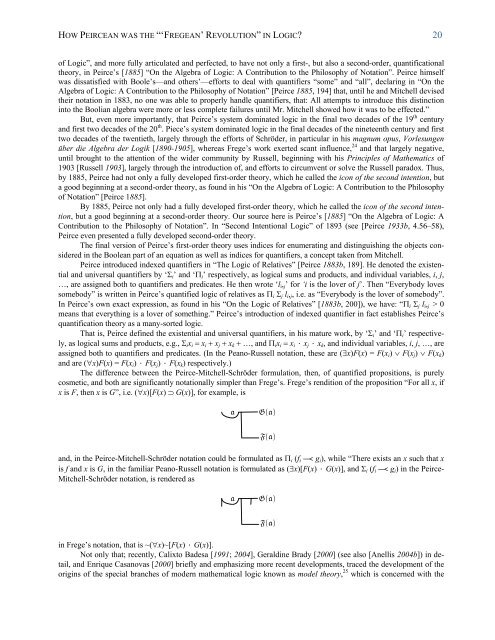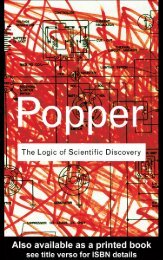You also want an ePaper? Increase the reach of your titles
YUMPU automatically turns print PDFs into web optimized ePapers that Google loves.
HOW PEIRCEAN WAS THE “‘FREGEAN’ REVOLUTION” IN LOGIC? 20<br />
of Logic”, and more fully articulated and perfected, to have not only a first-, but also a second-order, quantificational<br />
theory, in Peirce’s [1885] “On the Algebra of Logic: A Contribution to the Philosophy of Notation”. Peirce himself<br />
was dissatisfied with Boole’s—and others’—efforts to deal with quantifiers “some” and “all”, declaring in “On the<br />
Algebra of Logic: A Contribution to the Philosophy of Notation” [Peirce 1885, 194] that, until he and Mitchell devised<br />
their notation in 1883, no one was able to properly handle quantifiers, that: All attempts to introduce this distinction<br />
into the Boolian algebra were more or less complete failures until Mr. Mitchell showed how it was to be effected.”<br />
But, even more importantly, that Peirce’s system dominated logic in the final two decades of the 19 th century<br />
and first two decades of the 20 th . Piece’s system dominated logic in the final decades of the nineteenth century and first<br />
two decades of the twentieth, largely through the efforts of Schröder, in particular in his magnum opus, Vorlesungen<br />
über die Algebra der Logik [1890-1905], whereas Frege’s work exerted scant influence, 24 and that largely negative,<br />
until brought to the attention of the wider community by Russell, beginning with his Principles of Mathematics of<br />
1903 [Russell 1903], largely through the introduction of, and efforts to circumvent or solve the Russell paradox. Thus,<br />
by 1885, Peirce had not only a fully developed first-order theory, which he called the icon of the second intention, but<br />
a good beginning at a second-order theory, as found in his “On the Algebra of Logic: A Contribution to the Philosophy<br />
of Notation” [Peirce 1885].<br />
By 1885, Peirce not only had a fully developed first-order theory, which he called the icon of the second intention,<br />
but a good beginning at a second-order theory. Our source here is Peirce’s [1885] “On the Algebra of Logic: A<br />
Contribution to the Philosophy of Notation”. In “Second Intentional Logic” of 1893 (see [Peirce 1933b, 4.56–58),<br />
Peirce even presented a fully developed second-order theory.<br />
The final version of Peirce’s first-order theory uses indices for enumerating and distinguishing the objects considered<br />
in the Boolean part of an equation as well as indices for quantifiers, a concept taken from Mitchell.<br />
Peirce introduced indexed quantifiers in “The Logic of Relatives” [Peirce 1883b, 189]. He denoted the existential<br />
and universal quantifiers by ‘�i’ and ‘�i’ respectively, as logical sums and products, and individual variables, i, j,<br />
…, are assigned both to quantifiers and predicates. He then wrote ‘li,j’ for ‘i is the lover of j’. Then “Everybody loves<br />
somebody” is written in Peirce’s quantified logic of relatives as �i �j li,j, i.e. as “Everybody is the lover of somebody”.<br />
In Peirce’s own exact expression, as found in his “On the Logic of Relatives” [1883b, 200]), we have: “�i �j li,j > 0<br />
means that everything is a lover of something.” Peirce’s introduction of indexed quantifier in fact establishes Peirce’s<br />
quantification theory as a many-sorted logic.<br />
That is, Peirce defined the existential and universal quantifiers, in his mature work, by ‘�i’ and ‘�i’ respectively,<br />
as logical sums and products, e.g., �ixi���xi���xj���xk���…��and �ixi ��xi ��xj���xk, and individual variables, i, j, …, are<br />
assigned both to quantifiers and predicates. (In the Peano-Russell notation, these are (�x)F(x) = F(xi) � F(xj) � F(xk)<br />
and are (�x)F(x) = F(xi) � F(xj) � F(xk) respectively.)<br />
The difference between the Peirce-Mitchell-Schröder formulation, then, of quantified propositions, is purely<br />
cosmetic, and both are significantly notationally simpler than Frege’s. Frege’s rendition of the proposition “For all x, if<br />
x is F, then x is G”, i.e. (�x)[F(x) � G(x)], for example, is<br />
a G(a)<br />
and, in the Peirce-Mitchell-Schröder notation could be formulated as �i (fi ―< gi), while “There exists an x such that x<br />
is f and x is G, in the familiar Peano-Russell notation is formulated as (�x)[F(x) � G(x)], and �i (fi ―< gi) in the Peirce-<br />
Mitchell-Schröder notation, is rendered as<br />
F(a)<br />
a G(a)<br />
in Frege’s notation, that is ~(�x)~[F(x) � G(x)].<br />
Not only that; recently, Calixto Badesa [1991; 2004], Geraldine Brady [2000] (see also [Anellis 2004b]) in detail,<br />
and Enrique Casanovas [2000] briefly and emphasizing more recent developments, traced the development of the<br />
origins of the special branches of modern mathematical logic known as model theory, 25 which is concerned with the<br />
F(a)





